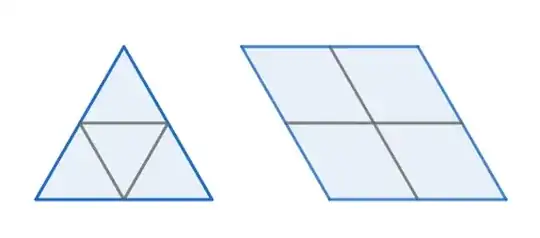One way to prove the Pythagorean Theorem is by noticing that its altitude divides it into two pieces similar to itself. The theorem immediately follows from the fact that areas scale with the square of the ratio and the ratios are determined by the sides of the big triangle.
The thing about this proof is that it doesn't seem to have anything to do with triangles. Wouldn't any family of shapes that can be - non- trivially - divided into similar copies of itself yield a similar result?
The condition for a non-trivial division is inspired by the fact that any triangle or parallelogram can be divided into four congruent copies of itself, but this division doesn't lead to any interesting equation.
I'm not sure what formal condition makes a division trivial, though.
One could argue that the $(\sqrt 2:1)$ parallelogram can be non trivially divided into two similar copies of itself. However, we can't really obtain any equation from it, since there is no degree of freedom on its sides.
Could it be that the right triangles consist of the only interesting family? Is the Pythagorean Theorem really that special?
Update 1: I just came across this article, which surprisingly proves that any polygon that can be divided into two similar copies of itself must be similar to one of the following:
As the parallelogram, the Golden Bee do not give us any equation. This already implies that the Pythagorean Theorem is, if not the only one, the simpler of its kind.
But that is not taking fractals into account:
Update 2: As told in a comment, a rep-tile is a polygon that decomposes into congruent copies of itself. Also, an irreptile (irregular rep-tile) is a polygon that decomposes into similar copies of itself (those are the interesting ones).
Searching for these terms led to some interesting places:
- This site gives some examples of irreptiles and discuss some results around them.
- In this presentation you can see lots of irreptiles to fire the imagination.
- This article gets into methods to build some irreptiles families.
Looking through those I had the impression that we won't get any interesting equation from a irreptile if it is divided into many pieces more then its number of sides.
That being said, the following shape called my attention:
This one leads to the equation $a^2+2b^2 = c^2$. However, this seems to be, again, a rigid shape, so we can't really choose $a$ and $b$.




